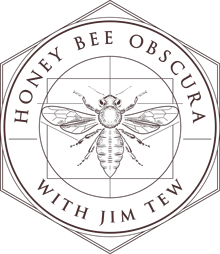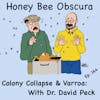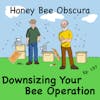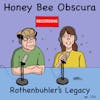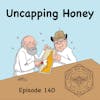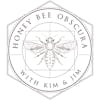Plain Talk: Spring - Help, Don't Hurt Your Bees

In this episode of Honey Bee Obscura, Jim takes beekeepers through the critical period of late winter and early spring, emphasizing the delicate balance between intervening in the hive and letting bees be. Drawing from his observations during an...
In this episode of Honey Bee Obscura, Jim takes beekeepers through the critical period of late winter and early spring, emphasizing the delicate balance between intervening in the hive and letting bees be. Drawing from his observations during an unseasonably warm day in Northeast Ohio, Jim shares his insights into the significance of weather for beekeeping and the implications of seasonal changes for bee activity. He delves into practical advice for beekeepers on how to conduct inspections without disrupting the bees' crucial activities during these rare nice days, suggesting a narrow window of time for minimal intrusion.
Jim explores the various aspects of hive management during this transitional period, including evaluating honey stores, supplementing with pollen, addressing potential queen issues, and the importance of early varroa treatment. With a conversational tone, he discusses the responsibilities beekeepers have towards their hives, stressing the need for careful decision-making to support the bees' health and readiness for the coming season. The episode also covers the handling of dead colonies, frame management, and biosecurity practices, underscoring the importance of cleanliness and disease prevention in the apiary.
Listeners are invited to join Jim in this thought-provoking discussion that blends practical advice with reflections on the deeper connection between beekeepers and their bees. Whether you're a seasoned beekeeper or just starting, this episode offers valuable insights into making the most of the spring season while ensuring the well-being of your hives.
Listen today!
______________________
Thanks to Betterbee for sponsoring today's episode. Betterbee’s mission is to support every beekeeper with excellent customer service, continued education and quality equipment. From their colorful and informative catalog to their support of beekeeper educational activities, including this podcast series, Betterbee truly is Beekeepers Serving Beekeepers. See for yourself at www.betterbee.com
______________________
Honey Bee Obscura is brought to you by Growing Planet Media, LLC, the home of Beekeeping Today Podcast.
Music: Heart & Soul by Gyom, All We Know by Midway Music; Christmas Avenue by Immersive Music; original guitar music by Jeffrey Ott
Cartoons by: John Martin (Beezwax Comics)
Copyright © 2024 by Growing Planet Media, LLC

Episode 171 – Plain Talk: Spring - Help, Don't Hurt Your Bees
Jim Tew: Listeners, yesterday was one of those days in Northeast Ohio. Vivid blue skies, gentle warm breeze. It just seemed like spring should be here, and it's not. Today it has rained all day, and it's back to normal. So much for the weather, but yesterday I went out and my bees were flying, and that's what I want to talk about. How do you help a wintering colony and not hurt it?
I'm Jim Tew. I come to you once a week here on Honey Bee Obscura, where one way or the other we talk about something to do with beekeeping. Today, I want to talk about how to help a wintering colony and not hurt it.
Introduction: Welcome to Honey Bee Obscura, brought to you by Growing Planet Media, the producers of the Beekeeping Today podcast. Join Jim Tew, your guide through the complexities, the beauty, the fun, and the challenges of managing honeybees. Jim hosts fun and interesting guests who take a deep dive into the intricate world of honeybees. Whether you're a seasoned beekeeper or just getting started, get ready for some plain talk that'll delve into all things honeybees.
Jim: It was just that day. At some point, I want to talk to you about the weather. Beekeepers, are we hyper-aware of the weather? Because if it's a beautiful day, bees are flying. If it's a rainy day, bees are not bringing in nectar. I think beekeepers may be more in tune with the weather than other people. In fact, I want my own weather station back there. I want to know exactly what the weather is in my yard but that's a talk for another time.
When I was back there in my yard yesterday, I thought this would be a good day to get the smoker out for the first time since late last or early last winter, fire that thing off, and let's just have a look at what's going on. I had this thought and I've had this thought over and over again during earlier episodes and different winters. This beautiful day when these bees are out flying is as important to them, more important to them than it is to me for checking them or whatever.
You see what I'm trying to say? The bees finally get a nice day, and then here comes this huge pest on this beautiful day to distract us, disorient us, tear into the colony, move things around on a day when the bees should be cleansing their bowels, rearranging honey stores, working on the brood nest. How do you help and not hurt the bees?
If you do make the decision that it's worth opening the colony on this rare, nice day in a cool climate, then I would recommend that you do it somewhere probably in the time frame of noon to two o'clock because the bees have been in this stupor, in this carbon dioxide stupor inside the hive in many cases, and they're waking up to stretching and yawning, and then by the time the word gets out throughout the cluster that it's a nice day, we can break up the cluster and go for a flight, it's probably going to be close to 11 o'clock or even lunch, I'm guessing.
Then for the bees to come back into the hive after their climatic break and reorganize, reclusterfy themselves, what? Two o'clock? You want to be done by two o'clock for sure, just to give them a chance to get all fixed before the sun begins to fade, the temp begins to drop, and then the next day like this, rain, cool, windy. I'm suggesting the window of noon till 2:00 for a hobby beekeeper making a casual inspection of what's going on there.
When you open it up, expect to see some brood. There's going to be, even here in northeast Ohio in the latter part of winter, there should already be some brood population there. Now here's the oddity, I'm talking to people all across the country, and I know in Alabama that I've already seen pictures of 2024 spring flowers and early nectar and pollen flows going on already in preparation for queen production.
You folks are already well beyond this. Anything that you're going to do for a late winter inspection is already done and your bees are built up and are weeks and weeks ahead of anything I'm talking about. Congratulations to you and envy, sent your way, for being so far along on this season. When you pull that out, expect to see some brood. Be as gentle as you can, have some idea of what you're looking for.
Listeners, this is not a lecture, this is a conversation because throughout the whole thing, I'm really worried about us, distracting the bees, not letting them be bees on this day that's valuable to them. On the other hand, we know we've got Varroa at some level in that box, we know possibly there's other disease issues. Are there enough honey stores? Because we agreed to be responsible for the bees when we took on being beekeepers.
These are not wild bees in a tree left to their own devices. We do have some obligation to check with them. One of the things I would suggest that those of us who are still in hard winter, especially people like me here in Northeast Ohio, this is a good time to put that supplemental pollen on. This is a reprimand to me in a cool climate, that if you're going to do this with supplemental pollen, do it now.
If I wait a few days, wait a few weeks, all of a sudden there's early blooming coming in, you go out and you say, oh, wow. It must be maple, the bees are bringing in pollen. They don't want your supplemental source then. If they're getting it naturally, you waited too late. I'm thinking, conversationally, not lecture-wise, I'm thinking that right about now, for me in this climate, is the time to be putting on those supplemental pollen patties.
Those of you who have issues with small hive beetles, there is a pollen patty lift that you can put the patty on that raises the pollen patty off the top frames enough that the bees can get under it and keep the beetles away from it. You might want to consider that if you're in a beetle-infested area. Feed that now, put the pollen patty up just above the brood nest area. I suspect and have always suspected that the bees are actually eating that patty as much to get it out of the colony as they are because they're nutritionally attracted to it.
When I put that pollen cake right in the middle of the colony, and I've got it positioned, I think the bees like that because it breaks up their colony flow and they work diligently to get it out. They don't have little buckets, little stainless steel mop buckets. The only way they can get this thing out is to eat it, drop it, and by removing it, they unintentionally eat some of it.
How about the honey? You're making radical decisions here on where the honey is, and you want to think that you're through the worst of the winter and happy days are here again, and that this is going to clear up, but you can't say that. I know that there's going to be some more hard freezes and really cold weather. If I suspect that that honey is not in the right place, then I'm going to move it around and try to get it right over the brood nest area.
I want to be sure that I don't get it too far away, I don't cause major confusion. In all cases, listeners, do no harm. Don't go wild and crazy, just shifting, moving, shifting, moving and make major changes. Queen issues. Here's some plain talk about queens. What are you going to do? If there's no queen there, if it's a good queen or a bad queen, or if you look and say, oh, wow, this is really a good queen. Look at the pattern she's got.
That's just here for the moment. That queen may not even be alive when you can really get into it next April or May. I wouldn't spend a minute worrying about the queen because I can't do anything if I found out my queen was dead. I can't buy one. I can't replace her. Oddly, a queen inspection is just a matter of curiosity for you. You'd say, well, maybe I'll combine the colonies.
Why would you do that to another beehive that's established, got itself set up? Why would you go through a mid-late winter colony combination process? I don't know that I would bother those. If that colony is queenless, plain talk, it's going to die. There's not much you can do. Let it go. Watch for robbing. As these colonies get these warm days, there is nothing out here in my area now. Of course, the one way you can tell that the colonies are vibrant and ready to go because they're checking every piece of equipment that ever had honey in it.
They're looking at old bee boxes, they're looking everywhere because there's nothing else to choose from, so they will rob from each other or from anywhere they can find it. Varroa treatment, good time to start that late winter varroa treatment. Do something. I want to take a break. I want to slightly change the subject, come back and talk to you about what to do with colonies that are already dead.
[music]
Betterbee: Are you an experienced beekeeper eager to try something new? Try making comb honey. Better Bee has you covered. Our range of ready-to-use systems, including hog half comb and Ross rounds, makes it a breeze to get started. Or craft your own cut comb right in your existing frames. With Better Bee's expert guidance, you'll soon be harvesting delicious comb honey. Explore the options at betterbee.com/combhoney.
Jim: Beekeeping is supposed to be this lovable, oh, I'm so happy to keep bees, I love keeping bees, it's so satisfying. Yes, go out and clean up some dead equipment and see how enjoyable that is. In a perfect world, beekeepers, I would suggest that if that colony is already dead, deal with the bulk of those bee bodies right now. Invariably what happens, you're all sappy and you think, well, I've still got three more colonies to look at. This one's already dead, I'm just going to put it back together. It's going to freeze again, it'll be okay, and I'll get back to it later in the spring and I'll clean it up then.
Invariably what happens in my case, when I do get back to it, it's putrefied, there's fly larvae that are degrading those dead bees that are there and it's just really a disgusting, slimy mess. Right now, when these bees are still freshly killed and frozen is the best time to get rid of them. It's also a great time to evaluate frames. Kim and I have talked in the past issues over and over again.
Kim was always emphatic, we need to get these frames out of here every two to three years. I'm closer to, I don't know, five to six years. You need to change the frames. When you're going through these dead outs and a frame that really is past its prime, been used a lot, going to be a lot of cleanup work, it's a good time to either rebuild it or just get rid of it.
Here's a personal note. As a young beekeeper all those years ago, I would give the bees some really despicable combs just to watch the miraculous recovery and rebuilding that the bees could do. If you're a young beekeeper and you want to watch and see how bees can recover and restore a comb, it is enjoyable to watch, but it's a lot of work for the bees. Would not it have been much better to get a new comb, new foundation insert, nice clean frame than it was to watch the bees restore some old frame that has seen its best years.
I stopped doing that for the most part, but I did do it, I enjoyed doing it. Do what's best for the bees after you get beyond this enjoyment concept. Do what's best for the bees when it comes to equipment reclamation. What should that reclaimed equipment look like? Right now, I'm just getting the bulk of the bees out of it, the dead bees so that that is gone and then I'll close that up as best I can because I don't want the mice to get in there, and to be rummaging around amongst those dead bees when they wake up from the winter month.
I'm basically balancing the frames. You can't get all the bees, the dead bees out of the combs. I balance the frames out, dump the bees out, shake them, clean it up, feel badly about it, tenderhearted that these bees died on my watch. Bees are dying on anybody's watch all the time. Bees are dying on their watch. Bees die all the time. They make plans to die. That's not a big deal as far as the scheme of things is concerned, but I still don't like to have to deal with them dying on my watch.
I told you a bit ago that we've agreed to do this bee thing. Now we've got these dead bees and the equipment that we paid for and assembled and it belongs to us. Here's that odd responsibility that we've incurred again. It'll be a good time now to clean that equipment, but not, like just back to pristine, but just enough that it's good to go and you won't have that slime stink when the weather warms up and you get back to it much later in the springtime season.
Can't paint now, don't even try it, too cold. I wouldn't bring that equipment in my shop. Maybe you've got a barn or a work area where you could warm it up enough for the paint to dry, but I wouldn't do it. Only got a minute or so left, but I want to discuss something that's been recently put on my mind by some of my co-workers here on these podcasts. Dr. Masterman and Dr. Peck got me thinking about biosecurity.
What does that mean in my bee yard? It means that I should be cleaner and neater and I should not be the guy who's transmitting diseases at the microscopic, maybe viral level. Bizarre recommendation to wash my bee suit. I'm the guy with a bee suit that hasn't been washed since I bought it, but now I'm considering washing it. Let me pose a question. What do you do with those dead bees? How much of this biosecurity situation are we intrigued with?
Should I be concerned when I tell you just to shake those bees out? Those bees died. I'm assuming they died from varroa. Varroa probably vectored a virus. If a yard stays in use for years, does it become infested? In other lectures, other discussions, people used to have horrific abhorrence to American foulbrood and would just go ballistic if an inspector even drove his car into their yard because they feared that the inspector was spreading American foulbrood from one yard to the other on his car tires, on the back of his smoker, on his gloves, on his hive tools.
Most bee inspectors have to be extremely fastidious, but I've always played that down. I said, no, those bacterial spores have to be in just the right place at just the right time by just the right age to be. Now I'm wondering if viral invaders are the same. I think that I've got-- well, I've got a burn pit in my yard and I think that rather than just be shaking bees here and shaking bees there, I'm going to take their carcasses over and put them in that burn pit.
It's an overkill. This is what I've told you. When you go into a late winter, early spring inspection, this is still late winter, really make it a needful inspection. Be realistic about what you can accomplish. Be quick, be gone. The bees need this time for their own lives far worse than you need the information that you're going to get. Secondly, if you've already got a dead out, I'm talking to you and to me. Deal with it right away, get it cleaned up. Don't put it off till later. It's not going to be any better later. It's just going to be worse later.
Get ready for spring, it's coming. I enjoyed talking to you. I'll look forward to doing it again. This is Jim telling you bye.
New to Honey Bee Obscura Podcast?
Here are some great episodes to start with. Or, check out episodes by topic.







 In this episode of Honey Bee Obscura, Jim takes beekeepers through the critical period of late winter and early spring, emphasizing the delicate balance between intervening in the hive and letting bees be. Drawing from his observations during an unseasonably warm day in Northeast Ohio, Jim shares his insights into the significance of weather for beekeeping and the implications of seasonal changes for bee activity. He delves into practical advice for beekeepers on how to conduct inspections without disrupting the bees' crucial activities during these rare nice days, suggesting a narrow window of time for minimal intrusion.
In this episode of Honey Bee Obscura, Jim takes beekeepers through the critical period of late winter and early spring, emphasizing the delicate balance between intervening in the hive and letting bees be. Drawing from his observations during an unseasonably warm day in Northeast Ohio, Jim shares his insights into the significance of weather for beekeeping and the implications of seasonal changes for bee activity. He delves into practical advice for beekeepers on how to conduct inspections without disrupting the bees' crucial activities during these rare nice days, suggesting a narrow window of time for minimal intrusion.
